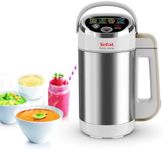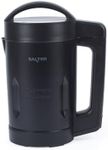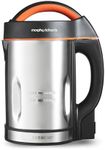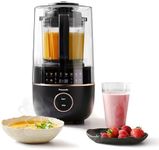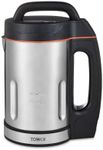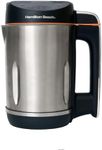Buying Guide for the Best Soup Makers
Choosing the right soup maker can make a big difference in your kitchen experience, especially if you love homemade soups. Soup makers are designed to simplify the process of making soup, allowing you to enjoy fresh, healthy meals with minimal effort. When selecting a soup maker, it's important to consider several key specifications to ensure you get the best fit for your needs. Here are some important factors to consider:CapacityCapacity refers to the amount of soup the maker can produce in one go. This is important because it determines how much soup you can make at once. Soup makers typically come in various sizes, ranging from small (around 1 liter) to large (up to 2 liters or more). If you are cooking for a small household or just yourself, a smaller capacity might be sufficient. However, if you have a larger family or like to batch cook, a larger capacity would be more suitable.
FunctionsSoup makers often come with different functions, such as blending, cooking, and even sautéing. These functions are important because they determine the versatility of the soup maker. Basic models may only blend and cook, while more advanced models can sauté ingredients before cooking, blend to different consistencies, and even make other dishes like smoothies or sauces. Consider what types of soups and other dishes you plan to make and choose a model with functions that match your cooking style.
Ease of CleaningEase of cleaning is a crucial factor because it affects how convenient the soup maker is to use regularly. Some soup makers have removable parts that are dishwasher safe, while others may require hand washing. Look for models with non-stick surfaces and easy-to-disassemble parts to make cleaning simpler. If you plan to use your soup maker frequently, choosing one that is easy to clean will save you time and effort.
Cooking TimeCooking time refers to how long the soup maker takes to prepare soup. This is important because it affects how quickly you can enjoy your meal. Some models can make soup in as little as 20 minutes, while others may take up to an hour. If you have a busy schedule and need quick meals, look for a soup maker with shorter cooking times. On the other hand, if you don't mind waiting a bit longer for a richer flavor, a model with longer cooking times might be suitable.
Control SettingsControl settings include the various options and programs available on the soup maker. These settings are important because they allow you to customize the cooking process to your preferences. Some soup makers have simple, manual controls, while others offer digital displays and pre-programmed settings for different types of soups. If you prefer a straightforward, no-fuss approach, a model with basic controls might be best. If you enjoy experimenting with different recipes and textures, look for a soup maker with more advanced settings.
MaterialThe material of the soup maker can affect its durability and performance. Common materials include stainless steel, plastic, and glass. Stainless steel is durable and often has a sleek appearance, but it can be heavier. Plastic models are lighter and often more affordable, but they may not be as durable. Glass can be a good option for those who prefer to see the cooking process, but it can be more fragile. Consider your preferences for durability, weight, and aesthetics when choosing the material.



